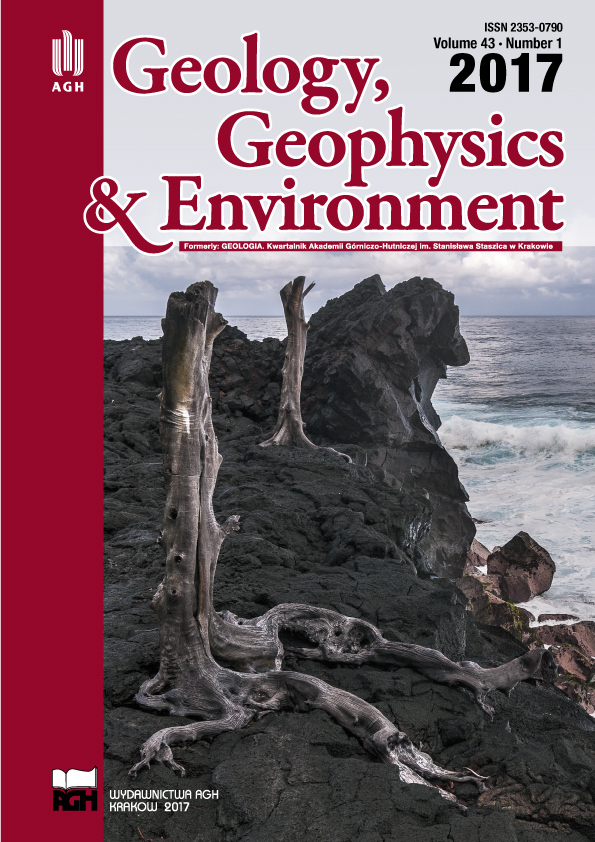A new empirical correlation for estimating bubble point pressure using the genetic algorithm
DOI:
https://doi.org/10.7494/geol.2017.43.1.33Keywords:
PVT properties, bubble point pressure, empirical correlation, Middle East, genetic algorithmAbstract
In this paper, a new and more accurate correlation to predict bubble point pressure (Pb) for Middle East crudes by using the genetic algorithm (GA) is attempted. For this purpose, a total of 286 data sets of different crude oils from Middle East reservoirs were used as training data for constructing the correlation. The general form of the correlation was found by several regressive examinations. To improve the correlation, the genetic algorithm was applied. To validate the correlation, 143 data sets of different crudes from Middle East reservoirs which were different from the training data were used as test data for calculating mean absolute relative error (MARE) and correlation coefficient (R2) between the predicted values from the proposed correlation and the experimental values. In addition, the MARE and R2 were calculated for previous correlation in the test data. The results show that the proposed correlation is more accurate than all of the previous correlations exclusively for Middle East crudes.
Downloads
References
Alenoghena C.O., Emagbetere J.O. & Edeko F.O., 2013. Application of Genetic Algorithm in Radio Network Coverage Optimization – A Review. International Journal of Computer Applications, 66, 48–52.
Al-Marhoun M.A., 1988. PVT correlations for Middle East crude oils. Journal of Petroleum Technology, 40, 650–666.
Almehaideb R.A., 1997. Improved PVT correlations for UAE crude oils. [in:] The SPE Middle East Oil Show, 15–18 March 1997, Manama, Bahrain, SPE-37691-MS, Society of Petroleum Engineers.
Al-Shammasi A.A., 2001. A review of bubble point pressure and oil formation volume factor correlations. SPE Reservoir Evaluation & Engineering, 4, 2, 146–160.
Dokla M. & Osman M., 1992. Correlation of PVT properties for UAE crudes. SPE Formation Evaluation, 7, 41–46.
Elsharkawy A.M., Elgibaly A.A & Alikhan A.A, 1995. Assessment of the PVT correlations for predicting the properties of the Kuwaiti crude oils. Journal of Petroleum Science and Engineering, 13, 219–232.
Farshad F., LeBlanc J.L., Garber J.D. & Osorio J.G., 1996. Empirical PVT correlations for Colombian crude oils. [in:] IV LAPEC: Proceedings of the Fourth Latin American and Caribbean Petroleum Engineering Conference: Port of Spain, Trinidad and Tobago, April 23–26, 1996, SPE-36105-MS, Society of Petroleum Engineers.
Gharbi R.B. & Elsharkawy A.M., 1997. Neural Network Model for Estimating the PVT Properties of Middle East Crude Oils. [in:] The SPE Middle East Oil Show, 15–18 March 1997, Manama, Bahrain, SPE-37695-MS, Society of Petroleum Engineers.
Ghetto G.D., Paone F. & Villa M., 1994. Reliability Analysis on PVT Correlations. [in:] European Petroleum Conference, 25-27 October, London, United Kingdom, SPE-28904-MS, Society of Petroleum Engineers.
Glaso O., 1980. Generalized pressure-volume-temperature correlations. Journal of Petroleum Technology, 32, 785– 795.
Hanafy H.H., Macary S.M., Elnady Y.M., Bayomi A.A. & El-Batanony M.H., 2005. Application of empirical PVT correlations exemplify significance of developing regional correlations – a new approach. [in:] Offshore Mediterranean Conference and Exhibition, 16–18 March 2005, Ravenna, Italy, OMC-2005-054.
Hemmati M.N. & Kharrat R., 2007. A correlation approach for prediction of crude oil PVT properties. [in:] The SPE Middle East Oil and Gas Show and Conference, 11–14 March 2007, Manama, Bahrain, SPE-104543-MS, Society of Petroleum Engineers.
Karimnezhad M., Heidarian M., Kamari M. & Jalalifar H., 2014. A new empirical correlation for estimating bubble point oil formation volume factor. Journal of Natural Gas Science and Engineering, 18, 329–335.
Kartoatmodjo T. & Schmidt Z., 1994. Large data bank improves crude physical property correlations. Oil and Gas Journal, 92, 27, 51-55.
Lasater J.S., 1958. Bubble point pressure correlation. Journal of Petroleum Technology, 10, 65–67.
Macary S.M. & El-Batanoney M.H., 1992. Derivation of PVT correlations for the Gulf of Suez crude oils. [in:] 11 th Petroleum Exploration and Production Conference, 12–14 March 1992, Egypt, Cairo, EGPC.
Mitchell M., 1998. An Introduction to Genetic Algorithms. 5 th ed., The MIT Press, Cambridge, Massachusetts, London.
Omar M.I. & Todd A.C., 1993. Development of new modified black oil correlations for Malaysian crudes. [in:] The SPE Asia Pacific Oil and Gas Conference, 8–10 February 1993, Singapore, SPE-25338-MS, Society of Petroleum Engineers.
Petrosky G. & Farshad F., 1993. Pressure-volume-temperature correlation for the Gulf of Mexico. [in:] The SPE Annual Technical Conference and Exhibition, 3–6 October, Houston, Texas, SPE-2664 4-MS, Society of Petroleum Engineers.
Ravandi Gh.E., Nezamabadi-Pour H., Monfared A.E. & Jaafarpour A.M., 2014. Reservoir Characterization by a Combination of Fuzzy Logic and Genetic Algorithm. Petroleum Science and Technology, 32, 840–847.
Standing M.B., 1947. A pressure volume temperature correlation for mixture of California oils and gases. [in:] API Drilling and Production Practice, API-47-275, Dallas, 275–287.
Vazquez M. & Beggs H.D., 1980. Correlation for fluid physical property prediction. Journal of Petroleum Technology, 32, 968–970.
Downloads
Published
Issue
Section
License
Authors have full copyright and property rights to their work. Their copyrights to store the work, duplicate it in printing (as well as in the form of a digital CD recording), to make it available in the digital form, on the Internet and putting into circulation multiplied copies of the work worldwide are unlimited.
The content of the journal is freely available according to the Creative Commons License Attribution 4.0 International (CC BY 4.0)










